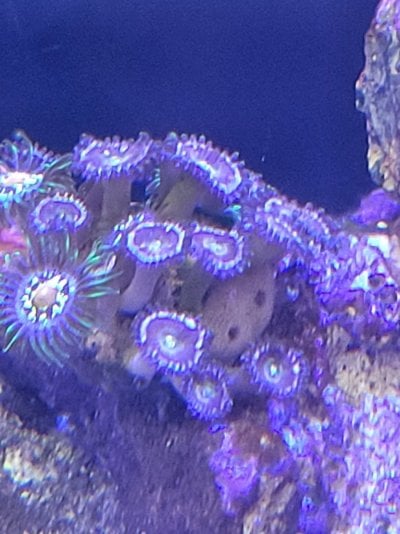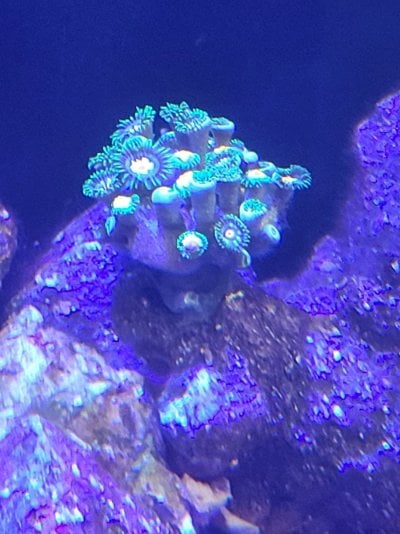Navigation
Install the app
How to install the app on iOS
Follow along with the video below to see how to install our site as a web app on your home screen.

Note: This feature currently requires accessing the site using the built-in Safari browser.
More options
You are using an out of date browser. It may not display this or other websites correctly.
You should upgrade or use an alternative browser.
You should upgrade or use an alternative browser.
Spores on zoas
- Thread starter Chirag96
- Start date
ISpeakForTheSeas
2500 Club Member
- Review score
- +0 /0 /-0
R2R Supporter
R2R Excellence Award
- Joined
- Nov 22, 2021
- Messages
- 3,058
- Reaction score
- 3,640
- Review score
- +0 /0 /-0
- Location
- United States
If the zoas the sponges are closest to look unhappy, it may be wise to remove them; but if the zoas are totally fine with them there, then the sponges are most likely harmless and fine to leave.
Most sponges are harmless even if they're growing around the base of zoas, but some of them will kill the zoas off with chemicals and/or grow over the top of them and smother the zoas. In either of these cases, you'd want to remove the sponge.
Most sponges are harmless even if they're growing around the base of zoas, but some of them will kill the zoas off with chemicals and/or grow over the top of them and smother the zoas. In either of these cases, you'd want to remove the sponge.
Thanks. Just physically removing them will solve this issue right?If the zoas the sponges are closest to look unhappy, it may be wise to remove them; but if the zoas are totally fine with them there, then the sponges are most likely harmless and fine to leave.
Most sponges are harmless even if they're growing around the base of zoas, but some of them will kill the zoas off with chemicals and/or grow over the top of them and smother the zoas. In either of these cases, you'd want to remove the sponge.
Thank you. Is there any fish or CUC that will eat this stuff?yes, but try to get all of it otherwise it can and will grow back.
Sponge
ISpeakForTheSeas
2500 Club Member
- Review score
- +0 /0 /-0
R2R Supporter
R2R Excellence Award
- Joined
- Nov 22, 2021
- Messages
- 3,058
- Reaction score
- 3,640
- Review score
- +0 /0 /-0
- Location
- United States
Maybe, maybe not:Thank you. Is there any fish or CUC that will eat this stuff?
Manual removal is typically the best from what I've seen:Just to put this out there - the problem with using biological controls (i.e. something that eats it) with sponges is that there are a ton of different sponges, some of which look indistinguishable from others. Some of these sponges are inedible or extremely undesirable foods to some species (either because of chemical defenses* or just because of taste preferences) while being highly desirable to other species. So, even if you pull in a known sponge-eating species of fish/starfish/whatever, there's no guarantee it will eat the sponge you want it to eat. Also, many of these sponge-eating species eat other things (like coral) that you might not want them eating.
Long story short, manual removal is probably your best option for sponges until more study has been on both specific sponges and specific sponge-eaters, but you can try it if you want.
*Just as a note on the chemical defenses of sponges, many sponges produce chemicals to avoid being eaten. Some of these chemicals are more generalized, some of them are specifically anti-fish, some are specifically anti-echinoderm (starfish, urchin, etc.), etc. So, again, some things might eat one sponge but not another, and because of the whole indistinguishable thing mentioned above, the sponges that are and are not being eaten may look pretty much identical (some may be distinguished/ID'ed under microscopic investigation, others may need to be DNA tested to be distinguished/ID'ed).
Just my two cents here.
ISpeakForTheSeas said:
The best way I've heard to control sponge growth at this point is to use a steel straw to scrape and siphon out the sponge you want to remove. Sometimes you can create bad conditions for them and kill them off that way, but that's typically much harder and not always effective.
Some other sponge removal methods:
ISpeakForTheSeas said:
Generally speaking, the easiest way to remove sponges is to scrape them off (the best recommendation I've seen for this is to scrape it off and suction it out).
Other suggestions include exposing the sponge to air (obviously not a guaranteed solution, and definitely not viable for this situation); hydrogen peroxide dipping the sponge (again, not viable here); injecting the sponge with hydrogen peroxide, vinegar, boiling water, or air; microbubbles in the display; and a few more. Predation is not usually a good solution for this issue, and I explain why below:
Similar threads
- Replies
- 7
- Views
- 232
- Replies
- 7
- Views
- 157
- Replies
- 4
- Views
- 160














